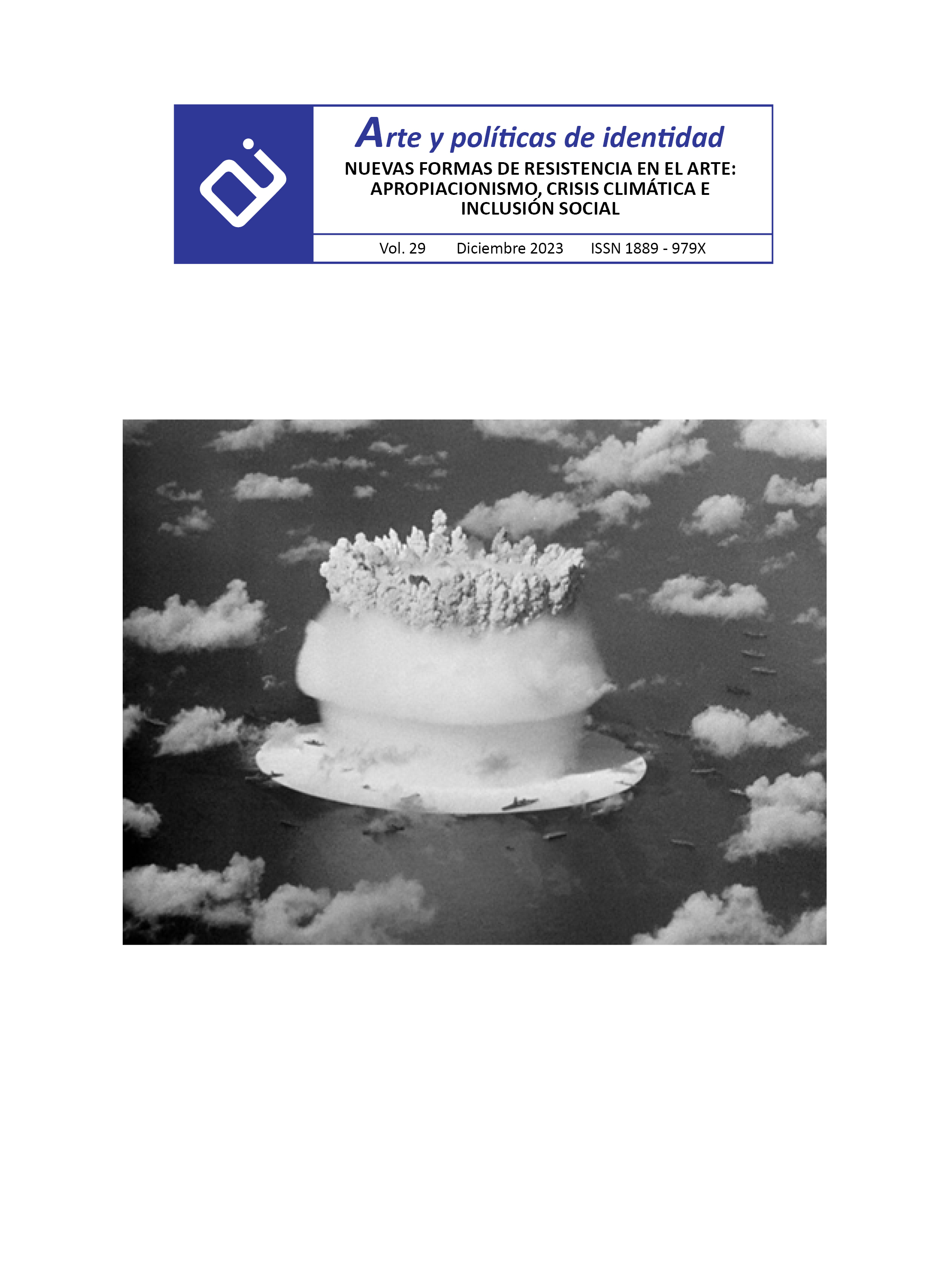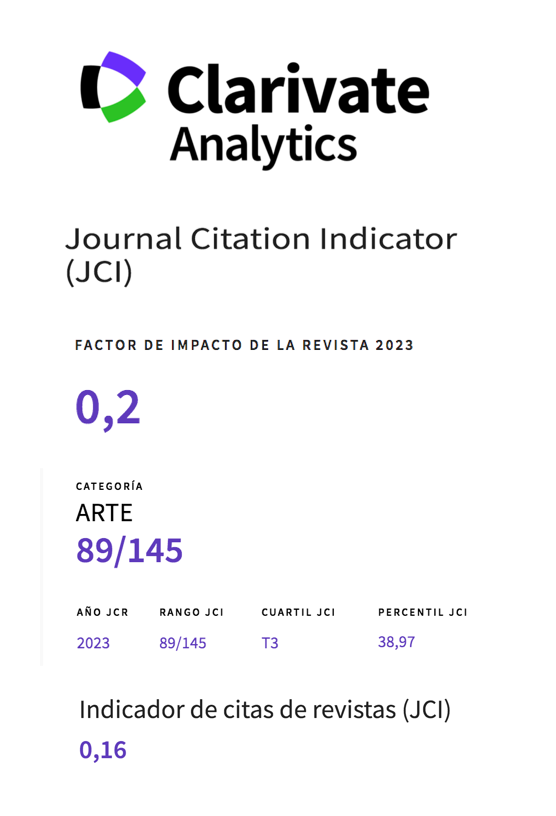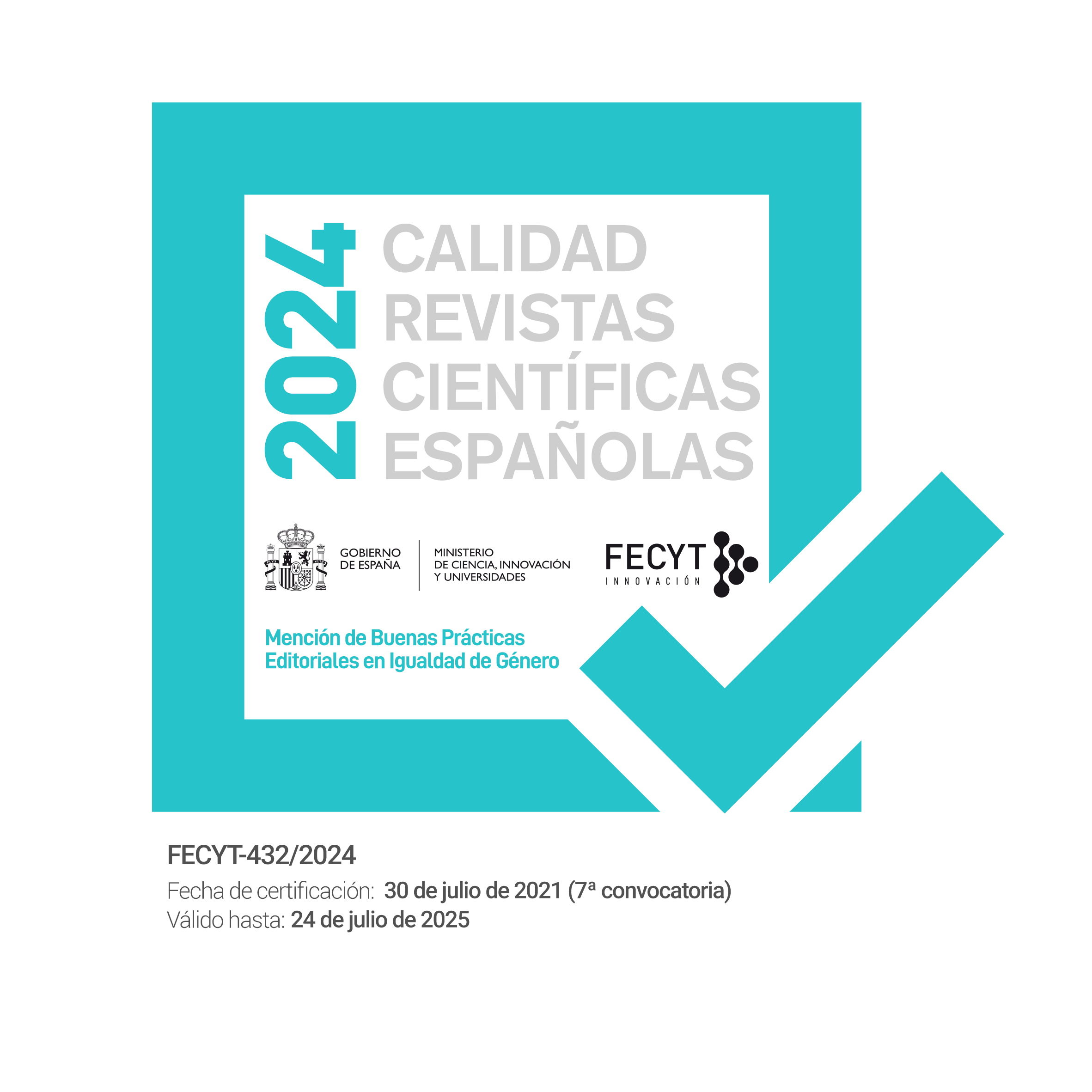El arte respuesta como activismo artístico. Ponerse en la Piel: un proyecto participativo de investigación basada en las artes sobre el aislamiento de las personas mayores
Resumen
En esta investigación se presenta un proyecto de activismo artístico y de investigación participativa basada en las artes que tiene por objeto transmitir los sentimientos de un grupo de personas mayores que viven en residencias. El proyecto constó de una exposición virtual y diversos talleres intergeneracionales basados en el arte (formato online y presencial) con el objetivo de sensibilizar y concienciar al espectador sobre esta problemática social. A nivel metodológico, se utilizaron cuestionarios en ambas experiencias (exposición y talleres) para analizar el impacto en los espectadores y participantes. El análisis de los cuestionarios informa de que la unión de ambas experiencias puede promover la sensibilización y concienciación del tema expuesto, siendo los espectadores-participantes activos como agentes de cambio, utilizando el arte como modo de expresión y reflexión. Con esta investigación se espera enriquecer las posibilidades que el activismo artístico tiene para la transformación social mostrando, a partir de una experiencia concreta, cómo la creación artística puede ser una herramienta útil para expresar y dar significado a la experiencia. Así mismo, se persigue el objetivo de proponer formas de participación activa del espectador (espectador participante) que convierten la experiencia artística en un agente de cambio comprometido socialmente.
Descargas
-
Resumen526
-
pdf258
Citas
Aladro-Vico, E., Jivkova-Semova, D., y Bailey, O. (2018). Artivismo: Un nuevo lenguaje educativo para la acción social transformadora. Comunicar, 57, 09-18. https://doi.org/10.3916/C57-2018-01
Amezcua, S. (7 de junio del 2021). Ana Gallardo: Una “Escuela de envejecer”, soñar y aprender a vivir. Primera página. https://primerapaginarevista.com/2021/06/07/ana-gallardo-una-escuela-de-envejecer-sonar-y-aprender-a-vivir/
Bishop, C. (2012). Artificial Hells: Participatory Art and the Politics of Spectatorship. Verso.
Corella, M. (2018). La recepción del concepto de agonismo en la teoría y la práctica artística: Agonismo sin hegemonía. En J.L. Villacañas y C. Ruiz (Eds.), Populismo versus republicanismo: Genealogía, historia, crítica (pp. 395-419). Biblioteca Nueva.
Dadswell, A., Bungay, H., Wilson, C., y Munn-Giddings, C. (2020). The impact of participatory arts in promoting social relationships for older people within care homes. Perspectives in public health, 140(5), 286–293. https://doi.org/10.1177/1757913920921204
Doucet, M., Pratt, H., Dzhenganin, M., y Leer, J. (2022). Nothing About Us Without Us: Using Participatory Action Research (PAR) and arts-based methods as empowerment and social justice tools in doing research with youth ‘aging out’ of care. Child Abuse & Neglect, 130(Pt 3), 105358. https://doi.org/10.1016/j.chiabu.2021.105358
Duncombe, S. (2016). Does it Work?: The Æffect of Activist Art. Social Research: An International Quarterly 83(1), 115-134. http://doi.org/10.1353/sor.2016.0005
Estudiantes de la UPV/EHU recogen la realidad de la pandemia vista por las personas mayores. (1 de julio de 2021). Naiz:.https://www.naiz.eus/es/info/noticia/20210701/estudiantes-de-la-upv-recogen-la-realidad-de-la-pandemia-vista-por-las-personas-mayores
Felshin, N. (1995). But is It Art?: The spirit of Art as Activism. Bay Press.
Garcés, L. (25 de julio del 2020). Paco Roca homenajea a los mayores. Las Provincias. https://www.lasprovincias.es/culturas/libros/paco-roca-homenajea-20200724204215-nt.html
González-García, R. (2019). El giro educativo del arte como herramienta para la transformación social en los nuevos museos del siglo XXI. Eikón Imago, 14, 199-216. https://revistas.ucm.es/index.php/EIKO/article/download/73434/4564456555361/4564456602779
Groot, B., y Abma, T. (2021). Boundary Objects: Engaging and Bridging Needs of People in Participatory Research by ArtsBased Methods. International Journal of Environmental Research and Public Health, 18(15), 7903. https://doi.org/10.3390/ijerph18157903
Helguera, P. (2012) Pedagogía en el campo expandido. https://latinamericanartathunter.org/uploads/Pedagogia_no_campo_expandido_-_8Bienal%20Spanish.pdf
Kapitan, L., Litell, M., y Torres, A. (2011). Creative Art Therapy in a Community’s Participatory Research and Social Transformation. Art Therapy, 28(2), 64-73. http://dx.doi.org/10.1080/07421656.2011.578238
Kaimal, G., Arslanbek, A., y Malholtra, B. (2022) Approaches to research in Art Therapy. En M. Rastogi, R.P. Feldwisch, M. Pate y J. Scarce (Eds), Foundations of Art Therapy. Theory and Applications (pp. 159-194). Academic Press. https://doi.org/10.1016/C2020-0-01197-7
Kramer-Roy, D. (2015). Using participatory and creative methods to facilitate emancipatory research with people facing multiple disadvantage: a role for health and care professionals. Disability & Society, 30(8), 1207-1224. https://doi.org/10.1080/09687599.2015.1090955
Leclerc, J., y Drapeau, C-E. (2018). Response-art as reflective inquiry: Fostering awareness of racism. The Arts in Psychotherapy, 60, 9-18. https://doi.org/10.1016/j.aip.2018.05.001
Macaya Ruiz, A., y Valero Antón, E. (2022). Arte participativo, comunidad y educación para el compromiso social. El proyecto Retrato de un Colectivo Vulnerable. ARTSEDUCA, (32), 9-24. https://doi.org/10.6035/artseduca.6068
MacLeod, A., Skinner, M. W., Wilkinson, F., y Reid, H. (2016). Connecting Socially Isolated Older Rural Adults with Older Volunteers through Expressive Arts. Canadian journal on aging = La revue canadienne du vieillissement, 35(1), 14–27. https://doi.org/10.1017/S071498081500063X
Martin, D. (2 de octubre de 2019). “How are you ageing today?” Art, Activism and Ageing. AgeingEqual. https://ageing-equal.org/how-are-you-ageing-today-art-activism-and-ageing/
Nash, G. (2019). Response art in art therapy practice and research with a focus on reflect piece imagery. International Journal of Art Therapy, 25(1), 39-48. https://doi.org/10.1080/17454832.2019.1697307
Nun, C. (2022). The participatory arts-based research project as an exceptional sphere of belonging. Qualitative Research, 22(2), 251-268. https://doi.org/10.1177/1468794120980971
Palacios, S. (26 de abril de 2020). Un olvido que debió ser antes noticia. El País. https://elpais.com/espana/madrid/2021-02-14/un-olvido-que-debio-ser-antes-noticia.html
Partridge, E.E. (2022). Art therapy and older adults. En M.
Rastogi, R.P. Feldwisch, M. y Pate, J. Scarce (Eds), Foundations of Art Therapy. Theory and Applications (pp. 379-412). Academic Press. https://doi.org/10.1016/B978-0-12-824308-4.00012-0
Pinazo-Hernandis, S. (2020). Impacto psicosocial de la COVID-19 en las personas mayores: problemas y retos. Revista Española de Geriatría y Gerontología, 55(5), 249-252. https://doi.org/10.1016/j.regg.2020.05.006
Potash, J.S. (2020). Situating activist art in art therapy. Art therapy, 37(3), 111-112. https://doi.org/10.1080/07421656.2020.1809307
Prado, M. (2011). Debate crítico alrededor de la Estética Relacional. Disturbis, (10), 0001-13. https://ddd.uab.cat/pub/disturbis/disturbis_a2011n10/disturbis_a2011n10a2/Prado.html
Rancière, J. (2004) Malaise dans l’esthétique. Galilée.
Rancière, J. (2008) Le spectateur émancipé. La Fabrique éditions.
ReasonWhy (13 de mayo del 2020). Survivors19, el proyecto creativo que denuncia el edadismo en el acceso a la atención hospitalaria. https://www.reasonwhy.es/actualidad/survivors19-proyecto-creativo-denuncia-discriminacion-edad-atencion-hospitalaria
Rubin, S.E., Gendron, T.L., Wren, C.A., Ogbonna, K.C., Gonzales, E.G., y Peron, E.P. (2015). Challenging Gerontophobia and Ageism Through a Collaborative Intergenerational Art Program. Journal of Intergenerational Relationships, 13(3), 241-254. http://dx.doi.org/10.1080/15350770.2015.1058213
Segal-Engelchin, D., Huss, E., y Sarid, O. (2021). The Use of Online CB-ART Interventions in the Context of COVID-19: Enhancing Salutogenic Coping. International Journal of Environtmental Research and Public Health, 18, Article 2057. https://doi.org/10.3390/ijerph18042057
Segal-Engelchin, D., Achdut, N., Huss, E., y Sarid, O. (2020). CB-Art Interventions Implemented with Mental Health Professionals Working in a Shared War Reality: Transforming Negative Images and Enhancing Coping Resources.
International journal of environmental research and public health, 17(7), 2287. https://doi.org/10.3390/ijerph17072287
Segura-Mariño, A-G., y Garcia-Umaña, A. (2019). El arte digital y su relación con la violencia de género. Revista de Humanidades, 38, 65-84
Smith, L., & Phillipson, L. (2021). Thinking through participatory action research with people with late-stage dementia: research note on mistakes, creative methods and partnerships. International Journal of Social Research Methodology, 24(6), 775-780. https://doi.org/10.1080/13645579.2020.1810997
Spaniol, S. (2005). “Learned Hopefulness”: An Arts-Based Approach to Participatory Action Research. Art Therapy, 22(2), 86-91. http://dx.doi.org/10.1080/07421656.2005.10129446
Suwito, K.A. (2020). Art and online activism amid the pandemic: lessons from around the world. The Conversation. https://theconversation.com/art-and-online-activism-amid-the-pandemic-lessons-from-around-the-world-140161
Viana, I. (28 de enero de 2021). Artistas, francotiradoras y activistas: las mujeres del polémico mural feminista del barrio de La Concepción. ABC. https://www.abc.es/historia/abci-artistas-francotiradoras-y-activistas-mujeres-polemico-mural-feminista-barrio-concepcion-202101280106_noticia.html
Yuen, F. (2016). Collage. An Arts-Based Method for Analysis, Representation, and Social Justice. Journal of Leisure Research, 48(4), 338–346. doi:10.18666/jlr-2016-v48-i4-6922
Derechos de autor 2023 Servicio de Publicaciones de la Universidad de Murcia

Esta obra está bajo una licencia internacional Creative Commons Atribución-NoComercial-SinDerivadas 4.0.
Works published in this journal are subject to the following terms:
- The Service of Publications from the University of Murcia (publishing house) keeps the published works’ copyrights, and favors and allows the reuse of these works under the license indicated in point 2.
- Works are published in the journal’s online edition under the license Creative Commons Reconocimiento-NoComercial-SinObraDerivada 3.0 España(texto legal). They can be copied, used, disseminated, transmitted and publicly exhibited, as long as: i) the author and original source of publication are cited (journal, publishing house and work’s URL); ii) they are not used for commercial purposes; iii) the existence and specifications of this license are mentioned.
3. Conditions for auto-file. It is allowed and encouraged that authors share electronically their pre-print version (the pre-reviewed version) and /or post-print version (the reviewed and accepted version) of their Works before the publication, since it promotes its circulation and dissemination. RoMEO color: green.










